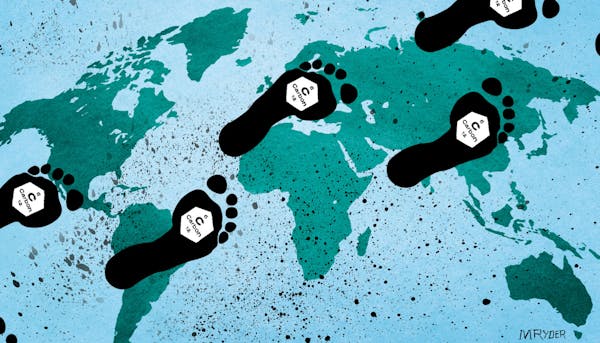Call it a hurricane, a superstorm, Frankenstorm or just plain Sandy. We'll call the epic meteorological sock to the nation's populous central Atlantic seaboard last week an agenda-changer. Climate change is suddenly more difficult for Americans to deny or ignore.
The nation has seen plenty of other signs that the climate is changing in ways consistent with scientific projections of a rapidly warming planet. This year alone has produced the warmest U.S. summer on record, the nation's second-largest wildfire by area, the biggest drought since the 1930s, the smallest expanse of Arctic Sea ice ever recorded, and ferocious megathunderstorms in places ranging from Duluth to Washington, D.C.
Still, climate change was held in such low regard among Americans that GOP presidential candidate Mitt Romney made President Obama's attention to the planet a laugh line at the Republican National Convention. The issue barely surfaced in presidential debates last month, and a Washington Post-Stanford University poll in June found climate change receding among Americans' concerns.
That changed with a whopper of a storm that took particular aim at the nation's largest and most iconic city. As was true when a different sort of tragedy occurred 11 years ago, when New York is stricken, the whole nation feels the pain.
In the days since Sandy made landfall, climate change conversations have popped up everywhere. Was this storm caused by global warming? Not directly, scientists say. But an Atlantic Ocean 9 degrees Fahrenheit warmer than normal this fall and New York area sea levels already a foot higher than a century ago are conditions that favor bigger, more frequent and more northerly hurricanes.
Is human activity causing this change? That's been the touchier question for politicians in the face of concerted efforts to discredit the conclusion that human-generated carbon emissions are a culprit. But the question is nearly settled in the scientific community. An overwhelming consensus points to human-generated greenhouse gases as a major driver of global warming. Those who would base this nation's policies on the credibility of the tiny minority of dissenters are taking a perilous risk -- as Sandy's U.S. death toll, nearing 100 at this writing, and its estimated $50 billion cost attest.
An election comes hard on Sandy's heels. As Romney himself acknowledged with his backhanded swipe at his party's convention, Obama has tried to advance policies that respond to climate change. Romney's 2011 suggestion that some portion of the Federal Emergency Management Agency ought to devolve to cash-strapped states seems almost silly today.
Tuesday's winner will be compelled to look anew at the nation's response to climate change. The policy considerations must have two aims: Carbon emissions into the atmosphere should be reduced, and defenses against weather extremes should be bolstered.
Energy policy will figure large in these conversations. A reexamination of nuclear power is in order to determine whether 21st-century technology can make it a safer and more sustainable option. So is a push for more renewable generation of electricity. A tax on carbon emissions ought not be dismissed out of hand.
In addition, government can encourage faster development and deployment of energy-saving technologies in transportation, heating, lighting and manufacturing. Inviting energy-saving lifestyle changes makes sense, too.
At the same time, America must get serious about upgrading its infrastructure to withstand harsher weather and higher sea levels. One intriguing idea is the creation of a public-private infrastructure bank, funded in part by an earmarked federal income tax surcharge and dispensed according to need-based criteria to shore up vulnerable places and critical services.
Before Sandy, such ideas may have been deemed radical. In the storm's wake, they're looking increasingly prudent.
Ukraine aid vote is a domestic and geopolitical inflection point



